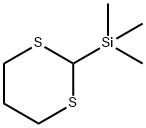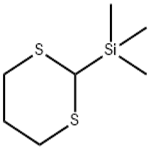
2-TRIMETHYLSILYL-1,3-DITHIANE
- Product Name2-TRIMETHYLSILYL-1,3-DITHIANE
- CAS13411-42-2
- CBNumberCB2671400
- MFC7H16S2Si
- MW192.42
- EINECS236-504-4
- MDL NumberMFCD00006655
- MOL File13411-42-2.mol
- MSDS FileSDS
Chemical Properties
| Boiling point | 54-55 °C0.17 mm Hg(lit.) |
| Density | 1.014 g/mL at 25 °C(lit.) |
| refractive index | n |
| Flash point | 205 °F |
| storage temp. | 2-8°C |
| solubility | Insol H2O; sol organic solvents. |
| form | clear liquid |
| color | Colorless to Light yellow to Light orange |
| Specific Gravity | 1.014 |
| Hydrolytic Sensitivity | 4: no reaction with water under neutral conditions |
| BRN | 1616463 |
| CAS DataBase Reference | 13411-42-2(CAS DataBase Reference) |
| UNSPSC Code | 12352100 |
| NACRES | NA.22 |
Safety
| Safety Statements | 23-24/25 | |||||||||
| RIDADR | 3334 | |||||||||
| WGK Germany | 3 | |||||||||
| F | 13 | |||||||||
| TSCA | No | |||||||||
| HS Code | 2934.99.9001 | |||||||||
| NFPA 704: |
|

